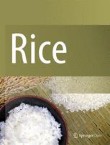Featured Scientist

Author published in"Rice"affiliate to
College of Science and Engineering
Ai-ling Hour
Department of Life Science,
Fu-Jen Catholic University, New Taipei City,Taiwan
Article published in
"Rice “volume 13, Article number: 82 (2020)
Genetic Diversity of Landraces and Improved Varieties of Rice (Oryza sativa L.) in Taiwan
Background
Rice, the most important crop in Asia, has been cultivated in Taiwan for more than 5000 years. The landraces preserved by indigenous peoples and brought by immigrants from China hundreds of years ago exhibit large variation in morphology, implying that they comprise rich genetic resources. Breeding goals according to the preferences of farmers, consumers and government policies also alter gene pools and genetic diversity of improved varieties. To unveil how genetic diversity is affected by natural, farmers’, and breeders’ selections is crucial for germplasm conservation and crop improvement.
Results
A diversity panel of 148 rice accessions, including 47 cultivars and 59 landraces from Taiwan and 42 accessions from other countries, were genotyped by using 75 molecular markers that revealed an average of 12.7 alleles per locus with mean polymorphism information content of 0.72. These accessions could be grouped into five subpopulations corresponding to wild rice, japonica landraces, indica landraces, indica cultivars, and japonica cultivars. The genetic diversity within subpopulations was: wild rices > landraces > cultivars; and indica rice > japonica rice. Despite having less variation among cultivars, japonica landraces had greater genetic variation than indica landraces because the majority of Taiwanese japonica landraces preserved by indigenous peoples were classified as tropical japonica. Two major clusters of indica landraces were formed by phylogenetic analysis, in accordance with immigration from two origins. Genetic erosion had occurred in later japonica varieties due to a narrow selection of germplasm being incorporated into breeding programs for premium grain quality. Genetic differentiation between early and late cultivars was significant in japonica (FST = 0.3751) but not in indica (FST = 0.0045), indicating effects of different breeding goals on modern germplasm. Indigenous landraces with unique intermediate and admixed genetic backgrounds were untapped, representing valuable resources for rice breeding.
Conclusions
The genetic diversity of improved rice varieties has been substantially shaped by breeding goals, leading to differentiation between indica and japonica cultivars. Taiwanese landraces with different origins possess various and unique genetic backgrounds. Taiwanese rice germplasm provides diverse genetic variation for association mapping to unveil useful genes and is a precious genetic reservoir for rice improvement. [Full article]

42 views